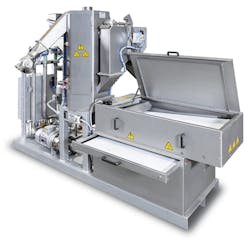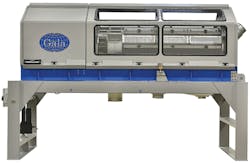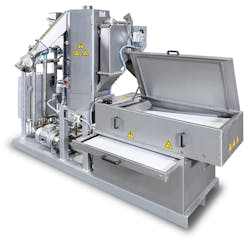NPE: Compounders broadening spectrum of capabilities
Compouding technology at NPE was abundant, which probably surprises many members of the plastics industry who don't get involved with it personally. The reality is that the industry is dependent on compounding to achieve the miracles clients routinely expect. And with new compounds being requested by processors and end users regularly, the challenges compounders are facing are many and growing.
What PMM saw and heard at the big show tells us compounding technology suppliers are more than aware of those challenges; they are doing something about them, and on many levels. From complete, integrated compounding systems to a valve that solves a stagnancy problem in a pelletizing line, myriad solutions were on display, and a selection of them follows.
Farrell Pomini, Ansonia, Conn., introduced at NPE a new model of the CP Series II Compact Processor that expands the line to seven models and boosts top-end output substantially. The production rate of the CP4000 model ranges from 5,500 to 11,000 pounds per hour, depending on the type of material, the amount and type of additives and fillers and other factors. The spectrum of resins that it will process is broad. PS, ABS, styrene acrylonitrile, thermoplastic polyurethane, thermoplastic olefin, polyamide, PLA and even temperature-sensitive materials such as recycled PVC and filled PVC can be compounded without compromising filtration or pelletizing, says the company.
Paul Lloyd, the company's business unit director, says the North American compounding market is still growing at about 4-5 percent annually and at higher rates in emerging markets. Farrel Pomini is concentrating its R&D on continuous mixers and, while selling globally, is still building all its machines in Connecticut where the company started more than 100 years ago. It is breaking ground for a new facility there.
The CP Series II Compact Processor's compactness is partly due to how it separates the mixing function—on the upper level of the machine—from the extrusion function on the lower level. Each function is independently controlled, which enables setting optimum process parameters for the mixing without impacting pelletizing and filtration. Along with component design, the machine architecture explains why the system is effective in dispersion of highly filled, highly pigmented materials.
lab pelletizer, cleated puller for pultrusion pelletizing
Pelletizing specialist Bay Plastics Machinery Co., Bay City, Mich., premiered two additions to its extensive pelletizer product lines at NPE. Jim Forgash, vice president of sales at family-owned BPM, says a pultrusion pelletizing customer that likes the quality of BPM machines asked the company to make a puller for its long-glass-fiber pultrusion line. Pultrusion is a growth sector that has become a major focus for Bay Plastics, he says.
The cleated belt puller shown at NPE is 40 inches wide and 32.5 inches long. Forgash notes that the machines are custom built to fit the client's pultrusion line. He describes the puller, which generates 4,000 to 6,000 pounds of pull force and can pull at rates from 2 to 140 feet per minute, as "very beefy and rigid." The cleats are replaceable for easy maintenance and an oscillating strand comb distributes wear across the cleated track for life cycle extension.
BPM's other new product at the show was the BP50 lab pelletizer, designed to meet the specific needs of labs at a price point below the least expensive production-level pelletizer. Forgash says companies were buying low-cost production pelletizers for lab work and paying for more than they needed. The BP50 is priced at $13,850 and available for quick shipment.
A key feature of the BP50 is the ease of making changeovers, a frequent necessity in a lab. The pelletizer will handle up to eight strands and, unlike most production pelletizers, features an open base that makes it easy to discharge into a drum.
High ROI pelletizer, rotational
valve and a tumbler
Gala Industries Inc., Eagle Rock, Va., introduced its new octagonal-shaped Tumbler for drying brittle materials and coating very sticky materials such as pressure-sensitive adhesive or polymer-modified hot-mix asphalt. Drum speed can be changed from 10 to 50 revolutions per minute; in tests rates of up to 4,000 pounds per hour were reached. Tilting allows different pellet retention times, including longer times to eliminate condensation. Easy-access doors allow easy cleaning and maintenance.
The new Model G3 pelletizer that Gala introduced at NPE bridges the gap between its Model 6 (up to 3,960 pounds per hour) and Model 7 (up to 13,200 pounds per hour). Though it's the same size as the Model 6, the G3's production rate is from 1,100 to 7,150 pounds per hour and is designed as a lower cost alternative for a higher return on investment.
Also debuting at the show was a new rotational valve for Gala's pellet conditioning system, which consists of multiple tanks that are gravity fed a slurry of pellets and fluid in a sequential pattern. The pellets can stick together if they are not kept moving. A pipe manifold controlled with full port ball valves has been used in the past, but sometimes pellets lying stagnant in a line not being filled cause a blockage. The rotational valve solves the problem.
FFS packaging, TS lab extruder,
strand pelletizer
Coperion Corp., Ramsey, N.J., exhibited an intelligent packaging machine with automation for compounders. The Coperion FFS Packaging Machine IBP 250 provides accurate weighing, dosing and hygienic packaging for crystalline, granular, beaded or flaked materials. Self-cleaning functions ease maintenance. The system features a small footprint, touchscreen controls and a modular design for easy upgrading.
NPE was the American debut of Coperion's redesigned ZSK 26 Mc18 twin-screw laboratory extruder, which offers increased torque and higher throughputs in a minimum of floor space. Heating and cooling systems are pre-installed for plug and play. Throughput range is 20 to 400 pounds per hour and feed enhancement side feeders and a side vent stuffer enhance this new extruder.
The SP 100 EN strand pelletizer presented in Coperion's booth has a working width of 3.94 inches and with 20 strands reaches throughput rates of 1,433 pounds per hour. The cutting head cover swings open for full access to the interior and the pellet outlet is accessible through the cutting head housing without disassembly.
Hub designs, belt-filtration
improve underwater pelletizers
Nordson BKG GmbH, Münster, Germany, displayed two new and very different improvements to its underwater pelletizers, each with big benefits to users. First up, the new, optional belt filter for the temperature-controlled water system of Nordson BKG Master-Line underwater pelletizers. It reduces downtime and operator intervention through continuous, automated filtration of fines.
Used for compounding and recycling, the Master-Line pelletizer is a compact, entry-level system with throughput capability of 4,400 pounds per hour. The new filter's 150-micrometer mesh is finer than the 200-micrometer filter standard of Master-Line pelletizers. Master-Line modularity means the new belt filter can be used to upgrade previously installed equipment.
Another advantage: Spray nozzles at one end and a scraper at the other constantly clean the continuously rotating filter screen, while fines are collected beneath the belt. In the standard system, fines are collected on a woven wire-mesh screen that periodically must be removed and cleaned, which requires stopping production.
Nordson BKG also showed off a new design for cutter hubs and blades used in its underwater pelletizers. Rotating rapidly against the die face, the hub and blade assembly makes pellets from polymer exiting holes in the die. Blades are mounted at either 45-degree (angled) or 90-degree (straight) angles to the die face. The new design increases the angled blades from 18 to 36 per hub and the straight blades from 26 to 40 per hub. That increases throughput. Alternatively, the pelletizer RPM can be reduced to reduce wear to the die plate and the blades.
The redesign used the same metal as the traditional blades but it was cast rather than machined. Adam Cowart, global product manager for Nordson BKG says, "Besides making possible an increase in the maximum number of blades, our new manufacturing method has enabled us to increase the space between the blades, reduce the volume of the cutter hub assembly, and use countersunk fasteners for mounting the blades to the hub."
Transportation of the pellets is improved, efficiency is enhanced, and pellet formation is improved, which is especially beneficial when making micropellets, with diameters smaller than 1mm. With the new design, the same hub can be used for angled or straight blades, a benefit when running multiple materials. The new-design hub and blades can be used on any Nordson BKG underwater pelletizer with throughputs from 2,200 to 77,000 pounds per hour.
Rob Neilley, senior correspondent
Contact:
Bay Plastics Machinery Co., 989-671-9630, www.bayplasticsmachinery.comCoperion Corp., 201-327-6300, www.coperion.comFarrel Corp., 203-736-5500, www.farrel-pomini.comGala Industries Inc., 540-884-2589, www.gala-industries.comNordson BKG GmbH, 49-251-26501-0, www.nordson-k.com



